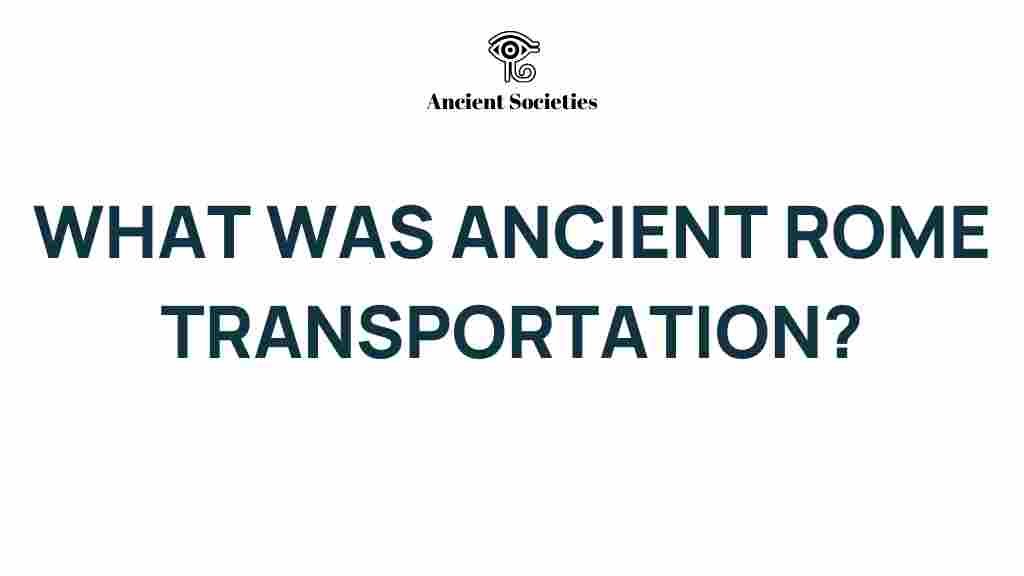Unveiling the Secrets of Ancient Rome’s Ingenious Transportation
Ancient Rome, known for its remarkable contributions to civilization, not only excelled in governance, law, and architecture but also in transportation infrastructure. The sophisticated network of roads, aqueducts, and trade routes played a crucial role in shaping Roman society and its economy. This article delves into the transportation systems of Ancient Rome, highlighting its engineering marvels and the impact they had on trade and daily life.
The Engineering Marvels of Ancient Rome
The engineering prowess of Ancient Rome is epitomized in its transportation systems. The Romans were not just builders; they were innovators who created durable and efficient infrastructure that would last for centuries.
Roads: The Backbone of Roman Transportation
One of the most significant achievements in Ancient Rome’s transportation history was the development of an extensive road network. The saying “All roads lead to Rome” is a testament to the efficiency of Roman roads. Here are some key points:
- Construction Techniques: Roman roads were built using multiple layers, including a base of large stones, a middle layer of smaller stones, and a top layer of gravel. This layering ensured durability and effective drainage.
- Standardization: The Romans standardized road construction, which allowed for uniformity and easier navigation across the empire.
- Milestones: Milestones were placed along roads to indicate distances, aiding travelers in planning their journeys.
The road network facilitated trade by connecting cities and regions, allowing for the efficient movement of goods and armies. Major roads, such as the Via Appia, became lifelines for the empire.
Aqueducts: The Lifeline of Cities
Aqueducts are another remarkable aspect of Roman engineering that contributed significantly to urban transportation. These structures transported water from distant sources into cities, improving public health and sanitation.
- Design and Function: Roman aqueducts utilized gravity to move water, often spanning valleys and hills through a series of arches and channels.
- Impact on Society: With reliable access to water, Roman cities could support larger populations and promote public baths, fountains, and other amenities.
The efficiency of aqueducts not only enhanced the quality of life but also supported the economic activities of Roman society by allowing for better agriculture and trade.
Trade Routes: Connecting the Empire
Ancient Rome’s transportation network was not limited to roads and aqueducts; it also included extensive trade routes that connected various parts of the empire and beyond.
Land and Sea Trade
Trade was vital to the Roman economy, and the transportation systems allowed for the movement of goods across great distances.
- Land Trade: Merchants used the road system to transport goods like grain, wine, and olive oil. The efficient road network reduced travel time and costs.
- Maritime Trade: The Romans also developed ports and ships, facilitating trade across the Mediterranean Sea. Key ports like Ostia became bustling trade centers.
In addition to goods, the movement of ideas and cultures was facilitated through these trade routes, contributing to the rich tapestry of Roman society.
The Societal Impact of Transportation
The transportation systems of Ancient Rome had profound effects on its society. From economic growth to cultural exchange, the impact was far-reaching.
Economic Growth
Transportation enabled the efficient distribution of resources, which led to economic prosperity. Key aspects include:
- Market Accessibility: Improved transportation made markets more accessible to producers and consumers, increasing trade volume.
- Job Creation: The construction and maintenance of roads and aqueducts created jobs and stimulated local economies.
Cultural Exchange
As goods and people moved across the empire, so did ideas and traditions. This cultural exchange enriched Roman society, leading to:
- Spread of Knowledge: Scholars and artisans traveled, sharing knowledge and skills.
- Integration of Cultures: Diverse cultures within the empire influenced Roman art, architecture, and customs.
The societal impact of transportation systems was integral to the cohesion and stability of the Roman Empire.
Challenges and Troubleshooting in Roman Transportation
<pDespite the remarkable advancements in transportation, the Romans faced challenges that required solutions. Here are some common issues and their resolutions:
Maintenance of Roads and Aqueducts
Over time, roads and aqueducts suffered from wear and tear. To address this, the Romans implemented:
- Regular Inspections: Officials were appointed to oversee the condition of roads and aqueducts.
- Repair Crews: Specialized crews were established to perform maintenance work.
Security Concerns
As trade routes expanded, so did the threat of banditry. The Romans took steps to enhance security:
- Military Presence: Roman legions were stationed along key trade routes to deter bandits.
- Patrols: Regular patrols were conducted to ensure the safety of travelers.
These measures helped maintain the integrity of transportation systems and protect the economic interests of the empire.
Conclusion: The Legacy of Roman Transportation
Ancient Rome’s transportation systems were a testament to the engineering skills and organizational abilities of its people. The roads, aqueducts, and trade routes not only facilitated commerce but also played a crucial role in the development of Roman society. The legacy of these innovations can still be seen today, as modern infrastructure continues to build upon the principles established by the Romans.
In summary, the transportation history of Ancient Rome is a fascinating study of how engineering and infrastructure can shape a civilization. To learn more about the impact of Roman engineering on modern infrastructure, check out this informative article.
Understanding the past helps us appreciate the complexities of our own societies and the systems that support them. The ingenuity of Ancient Rome serves as a reminder of the importance of effective transportation in fostering trade, community, and cultural exchange.
This article is in the category History and created by AncientSocieties Team
